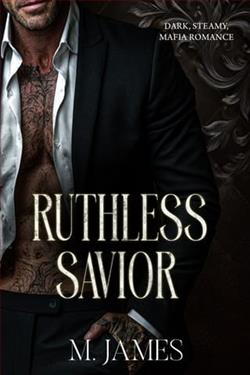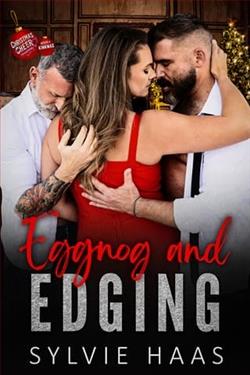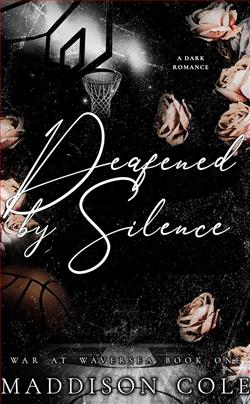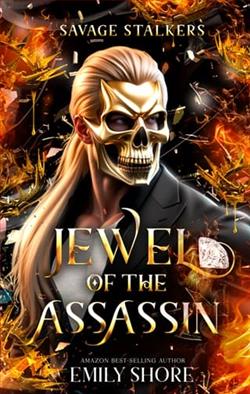Page 21 of Murder in Calusa Cove
“The good citizens of Calusa Cove don’t ring me at three in the morning. Not unless they know I’m on patrol.” Dawson shrugged. “We’re a small town. We do things a little backward, and I’m constantly telling people to call 9-1-1 because if they don’t get me on that first try, they’ve wasted precious seconds, but now we’ve digressed.” He waved his water at Hayes. “Keep going.”
“The second thing that’s bugging me is the location of the body,” Hayes said. “That section of the building was practically untouched by the fire. The door was left slightly ajar—almost as if it were inviting someone to look inside. I called Jenson, and he confirmed they found fire-retardant coating on the closet door and in parts of the room where the body was discovered—but not in the kitchen. That’s where they found traces of accelerant. It was used deliberately—enough to burn hot and fast, but not deep. Controlled. Purposeful.”
Hayes rubbed his temples. He’d worn a lot of hats in the Navy, but his primary roles on the SEAL team had been as a sniper and a medic. An unusual pairing, maybe—but those were the skills he’d excelled at.
This kind of thing—piecing together patterns, analyzing crime scenes—wasn’t his arena.
People had assumed he’d go into emergency medicine after his discharge and become an EMT or paramedic. It made sense on paper. But Hayes hadn’t wanted that. He’d craved something familiar, but not identical.
And truth be told, he liked running toward danger. Always had.
“I’ve got the report right here,” Chloe said, waving a sheet of paper in the air. “That move could’ve backfired on our killer—especially if Dewey hadn’t happened to walk by when he did. Fire retardant doesn’t stop flames, it. It just slows them down. And the kicker is, we don’t even know when that coating was applied.”
“I didn’t know Old Man Tomey well,” Dawson said. “But he was a cheap old bastard, and that building was days away from being shut down before he died. If not because of building code violations that he never fixed, it would have been by the health department.”
“That brings me to the third thing that doesn’t sit right,” Hayes said with a nod. “You believe this is the eighth murder linked to the Ring Finger Killer over the past thirty-five years. Out of those eight, how many were essentially handed to you?”
Buddy narrowed his eyes. “You’ll have to be more specific.”
“I mean, staged or presented in a way like the killer wanted you to find them,” Hayes clarified, gesturing with his hand. “Heather’s body was found less than twenty-four hours after she went missing—thanks to a tip about suspicious activity near the river, thirty miles from campus. Four others turned up in shacks, abandoned homes, or garages soon after being reported missing. Nothing ritualistic about them beyond the missing ring finger. One victim was found on the roadside, barely alive, and died en route to the hospital from a head injury. And the last two were pulled from the Intracoastal Waterway.”
“We know all that,” Buddy said. “And as much as we hate to speculate, we have to assume there are more victims—ones we haven’t found. No killer stretches their kills out this long without others slipping through the cracks. The only reason we’ve connected these is because Chloe went digging once she became an agent. The press hasn’t linked the murders—at least not yet. But this last one…it’s raising eyebrows. That reporter, Stacey, asked if the victim was missing a finger. I deflected and told her we hadn’t finished processing the scene or run the autopsy yet. Still, her question was...concerning.”
“I heard that, too,” Dawson said. “How would she even know about the ring fingers? That detail’s never been made public, and we certainly haven’t said anything about this latest victim.”
“We don’t know,” Buddy admitted, dragging a hand over his mouth. “But I’m curious where you’re going with this, Hayes.”
“Here’s the thing,” Hayes said. “It looks to me like, up until now, the killer didn’t want the victims found. He dumped them where they could be easily lost. Maybe his ritual got interrupted. But this time? It feels deliberate. This body was positioned to be found, and it certainly made a statement. So I keep asking myself—why now? Why Calusa Cove? Why is he stepping into the light after all this time?”
“I’ve thought the same,” Buddy said. “But we’ve never seen this guy stage a body before. And we still don’t understand his ritual. We don’t know much about what he does to the girls. How long he holds them before he kills them, though, based on Heather, it didn’t seem long. Setting a fire like that? It’s risky. Could’ve destroyed everything—evidence, the body, all of it. We might not have even realized it was him for a couple of days if the body had been burned in the fire. So I’m not ready to say he’s taunting us.”
“No, but it’s worth considering,” Hayes said.
“It’s a change in behavior—and that means something. We need to reexamine everything we know about the victims.” Chloe pushed back her chair, stood, and paced with one hand on her hip and the other fiddling with her ponytail.
Hayes had seen her do this many times when she’d been deep in thought over files she’d been combing through. He shouldn’t find it sexy, but he did. Intelligence, kindness, humility, and honesty always trumped beauty.
But Chloe was the complete package.
“In our research,” Chloe began, “we found that every victim had either cheated on their partner or left them for someone else. That’s why we think the ring finger is the trophy. It’s symbolic. Our theory is that the killer was either cheated on or abandoned—someone he loved left him and moved on. He’s carrying that wound. It drives him. But then we always question how he finds his victims. Is it personal? Random? Is he stalking? There are too many unknowns.” She paused, meeting Hayes’s eyes. “And the theory doesn’t hold completely. The victims all look different—blondes, brunettes, even a redhead.”
“So, he’s not killing the same person over and over,” Hayes said. He wished he had another milkshake—bad for the body, good for the brain. “Maybe he’s not seeking revenge on one woman but punishing a type—the kind of person who hurt him. Or...he thinks he’s doing people a favor. Helping others heal.”
“That second part is interesting,” Buddy said, tapping his finger against the table. “We usually assume he’s out to punish cheaters. I’ve never considered he might think he’s helping someone—avenging them. Why are you framing it that way?”
“Because I think both motivations can exist together,” Hayes replied, rubbing the back of his neck. He wasn’t sure he was even making sense, and he was surprised they cared what he thought. Calusa Cove didn’t get complex cases often, but when Dawson hit a wall, he turned to the team, just like in their SEAL days.
Although Hayes and Chloe often discussed her work, it had always been at a high level. Nothing detailed. He respected that. And he’d never seen himself as some criminal profiler. His strengths were waiting in stillness, breathing through chaos, and staying steady when others fell apart. Whether behind a sniper’s scope or treating the wounded bleeding out in the dirt, he didn’t second-guess. He acted.
“When you lose someone you love,” Hayes said, “you look for someone to blame. Some people get stuck in that. But others might twist that pain into something else—something they think is justice. What if this guy isn’t recreating the same relationship over and over, but instead thinks he’s helping others by removing the source of the betrayal? Some kind of bro code.”
“Maybe someone did that for him,” Chloe said softly. “Maybe the connection to the victims isn’t through the girls, but through the men they were in relationships with.”
“That’s possible,” Dawson muttered.
Chloe exhaled. “And we just made profiling him harder. The victims don’t fit a clear mold, and now we need to look at the men they were involved with.”
“Both in a relationship, and the ones they were cheating with,” Buddy added. “Victimology matters—and right now, what we have is thin. Hayes makes a good point, though. This feels different. Like the killer is changing tactics, maybe even toying with us.”















